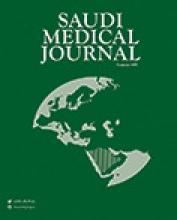To the Editor
It is an interesting observational study that has shown an increasing trend in the rates of papillary thyroid tumors in this region. It has clearly demonstrated an increase in pick up rate of early thyroid cancer. This pattern of detection of early thyroid cancer was also observed in the United States when ultra sound guided surveillance of thyroid lumps in routine practice was introduced some years ago.1
However, the question of why this trend is being observed has not been addressed. The diagnostic modality contributing towards earlier detection remains aloof and will merit a mention. One of the contributing factors could be better training of the experts utilizing the diagnostic modality that may be increasing the pickup rate. Last but not the least, availability of the pathologist/cytologist may be of some consequence as well.
I will also be keen to hear from the authors of the impact that this higher incidence will pose on the current service structures and in particular the outcomes. I would envisage increasing numbers of patients in clinics and higher pressure on the diagnostics that this will have. More importantly, the impact of early diagnosis and uncertainty that it creates in the patients mind, in particular that of younger patients and the psychological stress and impact on the lives. As reported, the numbers are observed to be increasing in younger females, as expected in view of the pathology and worldwide figures.
Lastly, it is surprising that other pathological subtypes have been excluded from the study. It would have been more informative if these had been included since it would have clarified the overall increasing trend and also any variations to the norm as reported in the literature.
Reply from the Author
Firstly thank you Dr for the comments and for reading the article “The rising trend in papillary thyroid carcinoma.”2
Secondly, please note the following:
1) Regarding your inquiry about other sub types of thyroid carcinoma, notice that this article from the start and from its title is designed for the study of papillary carcinoma in particular since it is the most common and it constitutes 92.7% of all cases. We only got 23 cases of other sub types which is very low number to come up with results regarding these sub types.
2) We did not specify when and what diagnostic methods are being used as to assume that it has an impact on the increased frequency results. But this was just a histopathologic retrospective study without including any clinical or radiologic data. And we defined the over diagnosis in the methods section as to be an “increase in the micro carcinoma cases and cases of early stage”, not only those that are detected by increased use of diagnostic methods. Although there is no doubt that these small tumors are being detected more frequently with the use of ultrasound and fine needle aspiration modalities. We have the intentions to do a more precise clinicopathologic study to come up with the exact correlation between the use of diagnostic tools and the increased frequency of this type of cancer.
3) As to other etiologic factors , we also hypothesized that radiation exposure in childhood could be a co-factor leading to the rising trend in this type of cancer, but this association needs more retrospective studies to prove it.
4) Regarding the impact of the study on the patients management, it is difficult to come up with a conclusion here from our histopathologic retrospective study, since this will need further follow up studies. However, most of the previous studies and autopsy findings suggest that micro carcinomas are of very low malignant potential.
5) Also, we did find an increase in papillary thyroid carcinoma cases of larger size not only the micro carcinomas, which makes the role of over diagnosis an important but not the only factor leading to our rising trends.
Manar Hajeer
The University of Jordan, Jordan University Hospital, Amman, Jordan
- Copyright: © Saudi Medical Journal
This is an open-access article distributed under the terms of the Creative Commons Attribution-Noncommercial-Share Alike 3.0 Unported, which permits unrestricted use, distribution, and reproduction in any medium, provided the original work is properly cited.






